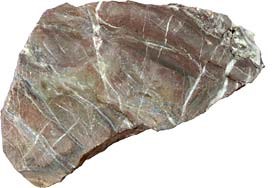
Where is limestone deposited? Limestone is a sedimentary rock rich in the mineral calcite, which is made of calcium carbonate. Franciscan limestone is formed mostly from the tiny carbonate shells of single celled marine animals called foraminifera. This type of limestone forms in ocean settings where there is not enough continental mud to dilute the slow “rain” of carbonate shells, and where the ocean is not so deep that all calcium carbonate dissolves into the water before it can be buried in the sediment to form rock. In today’s oceans, all calcium carbonate dissolves below the depth (called Carbonate Compensation Depth or CCD) of about 4 km. Franciscan limestone is thought to have formed on the tops and sides of underwater volcanoes in water less than 4 km deep.
What can the fossil shells tell us? Scientists have studied foraminifera found in sedimentary rocks. After identifying these fossils, geologists develop an evolutionary sequence of the species. This sequence, called a biostratigraphy, helps geologists determine the age of the rocks. The limestone in the Marin Headlands is too metamorphosed and recrystallized to contain original fossil shells, but other local Franciscan limestone contains fossils that tell us it was deposited from about 125 million ago to about 90 million years ago. 
|
Last updated: February 28, 2015
